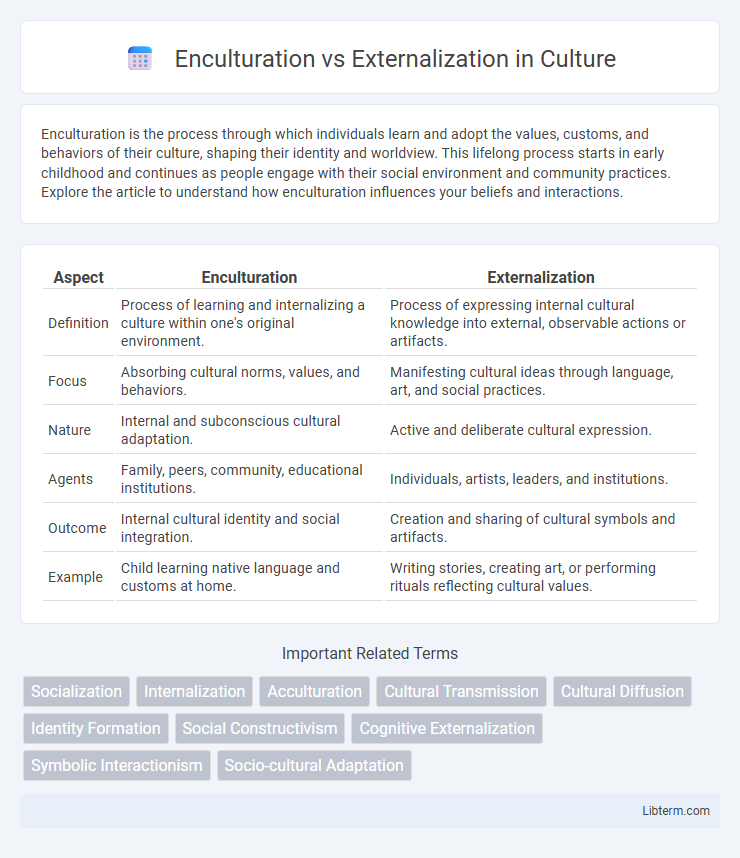Enculturation is the process through which individuals learn and adopt the values, customs, and behaviors of their culture, shaping their identity and worldview. This lifelong process starts in early childhood and continues as people engage with their social environment and community practices. Explore the article to understand how enculturation influences your beliefs and interactions.
Table of Comparison
| Aspect | Enculturation | Externalization |
|---|---|---|
| Definition | Process of learning and internalizing a culture within one's original environment. | Process of expressing internal cultural knowledge into external, observable actions or artifacts. |
| Focus | Absorbing cultural norms, values, and behaviors. | Manifesting cultural ideas through language, art, and social practices. |
| Nature | Internal and subconscious cultural adaptation. | Active and deliberate cultural expression. |
| Agents | Family, peers, community, educational institutions. | Individuals, artists, leaders, and institutions. |
| Outcome | Internal cultural identity and social integration. | Creation and sharing of cultural symbols and artifacts. |
| Example | Child learning native language and customs at home. | Writing stories, creating art, or performing rituals reflecting cultural values. |
Understanding Enculturation: Definition and Key Concepts
Enculturation refers to the process by which individuals learn and internalize the values, beliefs, norms, and customs of their culture through direct and indirect exposure from family, education, and social interactions. This ongoing cultural acquisition shapes behavior, identity, and worldview, enabling individuals to function effectively within their society. Key concepts of enculturation include socialization agents, cultural transmission, and the unconscious absorption of cultural knowledge during early developmental stages.
What is Externalization? Meaning and Core Principles
Externalization refers to the process of expressing internal ideas, knowledge, or experiences into an external form such as language, art, or technology. This concept is fundamental in knowledge management and organizational learning, where tacit knowledge is transformed into explicit knowledge that can be shared and utilized by others. Core principles of externalization include articulation, interpretation, and codification, enabling individuals or groups to convert personal insights into accessible and communicable formats.
Differences Between Enculturation and Externalization
Enculturation involves the process by which individuals internalize cultural norms, values, and behaviors through socialization within their native environment, while externalization refers to the manifestation or expression of internal cultural knowledge into tangible forms such as language, art, or rituals. The key difference between enculturation and externalization lies in their directional flow: enculturation is an inward process of acquiring culture, whereas externalization is an outward projection and communication of that culture. Enculturation shapes individual identity subconsciously over time, but externalization actively influences social interaction and cultural evolution by sharing internalized meanings with others.
The Role of Culture in Shaping Behavior
Enculturation deeply influences behavior by transmitting cultural values, norms, and beliefs through socialization processes within family, education, and community settings. Externalization reflects how individuals express internalized cultural elements outwardly, shaping actions, rituals, and communication patterns visible in social interactions. Together, these processes highlight culture as a dynamic force continuously constructed and manifested through learned behavior and social expression.
How Enculturation Influences Social Identity
Enculturation shapes social identity by embedding cultural norms, values, and traditions within individuals from a young age, fostering a sense of belonging and continuity within social groups. Through language acquisition, rituals, and shared practices, enculturation internalizes collective beliefs that define group membership and influence social behavior. This process reinforces cultural heritage and social cohesion, distinguishing group identity from external influences or individual externalization of culture.
Externalization: Projecting Ideas into the Social World
Externalization refers to the process through which individuals project their internal ideas, beliefs, and values into the social world, transforming subjective knowledge into objective reality. This cultural mechanism enables shared understanding and communication by manifesting thoughts into language, symbols, and social institutions. Through externalization, personal cognitive constructs become tangible frameworks shaping collective behavior and social norms.
Enculturation and Externalization in Everyday Life
Enculturation shapes individual behavior by embedding cultural norms and values through social interactions, family traditions, and educational systems, influencing language, customs, and belief systems in everyday life. Externalization occurs when individuals express these internalized cultural constructs through actions, rituals, and communication, thereby reinforcing and transforming social realities. Together, enculturation and externalization create a continuous cycle where cultural knowledge is internalized and manifested, sustaining societal cohesion and identity.
The Impact of Technology on Cultural Processes
Enculturation involves the internalization of cultural norms and values through socialization within a community, while externalization refers to the expression and materialization of culture through artifacts and technology. The impact of technology on cultural processes accelerates externalization by enabling rapid creation, dissemination, and transformation of cultural content across global networks. Digital platforms and virtual environments facilitate new forms of cultural expression and reconfigure traditional enculturation pathways, influencing identity formation and cultural continuity.
Case Studies: Real-World Examples of Enculturation vs. Externalization
Case studies reveal that enculturation shapes individual behavior through immersion in cultural norms, evident in tribal communities where language and rituals transmit identity across generations. Externalization manifests in technology startups, where entrepreneurs codify internal ideas into products influencing market behaviors beyond their original culture. Organizations like multinational corporations demonstrate both processes by internalizing diverse workplace norms (enculturation) and externalizing innovations globally to reshape industry standards.
Navigating Cultural Change: Adapting to New Contexts
Enculturation involves the internalization of cultural norms, beliefs, and values through direct immersion and socialization, enabling individuals to navigate new cultural contexts authentically. Externalization refers to expressing and sharing internal cultural understandings in external behaviors, symbols, and practices, facilitating adaptation during cultural change. Successful navigation of cultural change requires balancing enculturation by learning intrinsic cultural frameworks and externalization by actively applying and communicating these frameworks in evolving social environments.
Enculturation Infographic

 libterm.com
libterm.com